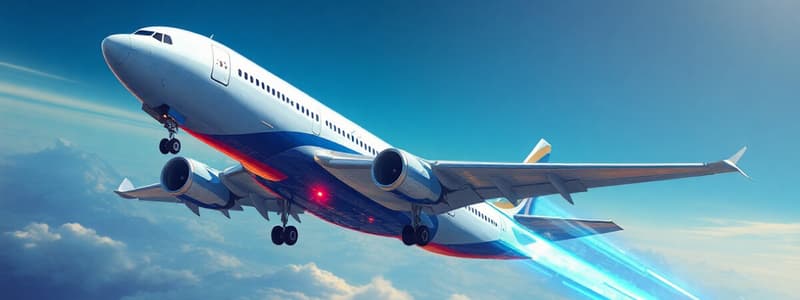Podcast
Questions and Answers
What is the primary function of a leading-edge high-lift device?
What is the primary function of a leading-edge high-lift device?
- To reduce fuel consumption during cruise.
- To increase drag during climbing.
- To extend the lift curve to a higher angle of attack. (correct)
- To decrease the stall speed of the aircraft.
Which aircraft configuration involves no deployment of high-lift devices?
Which aircraft configuration involves no deployment of high-lift devices?
- No deployment. (correct)
- Fully extended.
- All systems operational.
- Partially deployed.
What is a key difference between a Kruger flap and a Fowler flap?
What is a key difference between a Kruger flap and a Fowler flap?
- Kruger flaps deploy only at high speeds.
- Kruger flaps increase the effective camber only.
- Fowler flaps retract into the wing when not in use.
- Fowler flaps extend the wing area and also increase lift. (correct)
What is the effect of extending the flap hinge on a slotted flap?
What is the effect of extending the flap hinge on a slotted flap?
What happens when a leading edge slat is deployed?
What happens when a leading edge slat is deployed?
What is the primary effect of high lift devices on the lift curve?
What is the primary effect of high lift devices on the lift curve?
Which two figures of merit are used to evaluate the quality of an airfoil?
Which two figures of merit are used to evaluate the quality of an airfoil?
What does the L/D ratio indicate regarding flight performance?
What does the L/D ratio indicate regarding flight performance?
What is the maximum lift coefficient of the F-104 at subsonic speeds?
What is the maximum lift coefficient of the F-104 at subsonic speeds?
What causes an increase in lift when using flaps?
What causes an increase in lift when using flaps?
What impact does the sharp leading edge of the F-104's wing have on its performance?
What impact does the sharp leading edge of the F-104's wing have on its performance?
Which of the following flaps types is known for its ability to increase lift significantly during takeoff and landing?
Which of the following flaps types is known for its ability to increase lift significantly during takeoff and landing?
What is the effect of the thickness of a wing on its aerodynamic performance?
What is the effect of the thickness of a wing on its aerodynamic performance?
What advantage does the Boeing 727 have due to its high lift coefficient of 3.0?
What advantage does the Boeing 727 have due to its high lift coefficient of 3.0?
What aerodynamic feature of the Boeing 727 contributes to its low stall speed?
What aerodynamic feature of the Boeing 727 contributes to its low stall speed?
What aspect of the F-104 G’s performance is indicated by its stall speeds of 68.11 m/s and 88.53 m/s?
What aspect of the F-104 G’s performance is indicated by its stall speeds of 68.11 m/s and 88.53 m/s?
Why did the engineers of the Boeing 727 choose to maximize CL,max instead of increasing wing area?
Why did the engineers of the Boeing 727 choose to maximize CL,max instead of increasing wing area?
What is true about the trailing edge flaps of an airfoil?
What is true about the trailing edge flaps of an airfoil?
How does increasing camber affect the performance of an airfoil?
How does increasing camber affect the performance of an airfoil?
What design feature of the Boeing 727 helps it operate from shorter runways?
What design feature of the Boeing 727 helps it operate from shorter runways?
What was a trade-off for achieving a higher CL,max in the Boeing 727?
What was a trade-off for achieving a higher CL,max in the Boeing 727?
Flashcards
Leading-edge high-lift device
Leading-edge high-lift device
A thin, curved surface deployed in front of the wing's leading edge to increase lift and reduce stall speed.
Effect of leading-edge slat
Effect of leading-edge slat
Extends the lift curve to a higher angle of attack, allowing for greater lift without stalling, but doesn't change the maximum lift coefficient.
Kruger flap
Kruger flap
A leading-edge high-lift device that extends forward and downward, increasing wing area and lift.
Fowler flap
Fowler flap
Signup and view all the flashcards
Slat driving mechanism
Slat driving mechanism
Signup and view all the flashcards
Lift Augmentation
Lift Augmentation
Signup and view all the flashcards
Slats
Slats
Signup and view all the flashcards
Flaps
Flaps
Signup and view all the flashcards
Lift Coefficient (Cl)
Lift Coefficient (Cl)
Signup and view all the flashcards
Stall Speed
Stall Speed
Signup and view all the flashcards
Wing Loading
Wing Loading
Signup and view all the flashcards
L/D (Lift-to-Drag Ratio)
L/D (Lift-to-Drag Ratio)
Signup and view all the flashcards
Maximum Lift Coefficient (Clmax)
Maximum Lift Coefficient (Clmax)
Signup and view all the flashcards
Factors Affecting Stall Speed
Factors Affecting Stall Speed
Signup and view all the flashcards
Trailing Edge Flap
Trailing Edge Flap
Signup and view all the flashcards
Camber
Camber
Signup and view all the flashcards
How Trailing Edge Flaps Affect Camber
How Trailing Edge Flaps Affect Camber
Signup and view all the flashcards
High-Lift Devices
High-Lift Devices
Signup and view all the flashcards
Boeing 727 Design
Boeing 727 Design
Signup and view all the flashcards
Calculating Stall Speed
Calculating Stall Speed
Signup and view all the flashcards
Study Notes
Forces on an Aircraft
- Four main forces act on an aircraft: thrust, lift, weight, and drag.
- Thrust propels the aircraft forward.
- Lift opposes the weight, enabling the aircraft to fly.
- Weight is the force of gravity acting on the aircraft.
- Drag opposes the thrust, resisting the aircraft's motion.
Lift Augmentation
- Trailing-edge flaps increase lift and decrease stall speed.
- This allows for slower flight speeds while maintaining control.
- Slats, also called leading-edge flaps, are used to increase the lift at higher angles of attack.
- This delays the stall.
- A slot in the leading edge of the wing forces air under the wing, increasing the lift.
- Slots and slats can be used to allow the outer portion of the wing to maintain its lift after the root has stalled.
- Different types of flaps include plain, split, slotted, and Fowler.
Effect of Different Flap Types
- The type of flap used effects the lift and drag characteristics of the wing.
- Plain flaps increase lift and drag.
- Split flaps increase lift but also increase drag.
- Slotted flaps increase lift to a greater extent than plain or split flaps.
- Fowler flaps increase lift more compared to the other types.
- Fowler flaps increase the lift coefficient to a higher value.
Figures of Merit
- L/D (Lift-to-Drag ratio) represents aerodynamic efficiency.
- The range of an aircraft is directly proportional to L/D.
- Cl,max (Maximum lift coefficient) determines the stalling velocity (Vstall).
- It affects a plane's takeoff and landing performance.
Impact of High-Lift Devices
- Cl,max increases.
- Al=0 shifts to more negative values.
- The lift curve shifts to the left.
- Stall speed decreases.
Examples
- The Lockheed F-104 and Boeing 727 are examples of aircraft using high-lift devices.
- Calculations for stalling speeds for different fuel configurations are presented.
Trailing-Edge Flap
- A portion of the trailing edge section of the airfoil that can be hinged and deflected.
- Deflecting it upward or downward changes the lift curve.
- Upward deflection - lift curve is extended to a higher angle of attack.
- Downward deflection - lift curve shifts to the left.
- By changing the camber, the amount of lift generated by the wing changes.
- The flap angle change affects the angle of attack to increase or decrease the lift generated based on a given angle of attack.
- The use of this device slightly decreases the stall angle of attack.
Leading-Edge High-Lift Devices
- A thin, curved surface deployed in front of the leading edge.
- Increases Cl,max and decreases stall.
- Different types of leading edge high-lift devices include slats, droop, and Kruger flaps.
- Slats, droop, and Krueger flaps operate by changing the shape or altering the angle of attack to increase lift, decreasing stall, and increasing lift coefficient (Cl,max).
Various Configurations
- Different configurations of high-lift devices are used for different aircraft situations (e.g., cruise, takeoff, landing).
- A high-lift device is used to extend the lift coefficient.
- Flaps are a type of high-lift device.
- High lift devices are helpful in reducing the stalling angle of attack.
Driving Mechanism of Slat
-
Mechanisms for extending and retracting slats are described.
-
Specific examples such as the Mc Donnell Douglas slat mechanism are mentioned.
-
Different types of high-lift devices and mechanisms are displayed.
Conclusion
- The notes cover various aspects of aircraft lift augmentation strategies, including forces, figures of merit, device types, and mechanisms.
Studying That Suits You
Use AI to generate personalized quizzes and flashcards to suit your learning preferences.
Related Documents
Description
Test your knowledge on the primary functions and configurations of high-lift devices in aerodynamics. This quiz covers various types of flaps and their effects on aircraft performance, focusing on lift curves, airfoil merits, and specific aircraft examples like the F-104. Perfect for aviation students and enthusiasts looking to deepen their understanding of lift generation.




